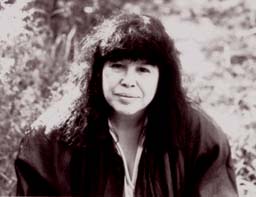
Photo:Ira Wood (source)Welsh father and Jewish mother, Piercy is under the influence of her mother and maternal grandmother in her belief in Judaism.
She grew up in a working-class family in Detroit; got active as a leftist feministin the anti-war and feminist movements in the 60's.
Piercy says that Woman on the Edge of Time (1976), arose from 'a tension between the harshness of much of my earlier life and the gratitude I felt toward the land where I was living. . . . It was also the first of my works to pay some sort of homage backward to my mother, for there is a lot of her in the character of Consuelo Ramos.'" (Contemporary Authors Autobiography Series)
1. Feminist Utopia as a Genre: (source Booker 337-)2. Women's position in the relations of Production and Reproduction:
- "Centrally concerned with the clash between individual desire and societal demand, Dystopian fiction often focuses on sexuality and relations between the genders as elements of this conflict." (e.g. We, The Brave New World, 1984.) (337)
- Despite giving frequent lip service to equality of genders, literary dystopias (and utopias, for that matter) have typically been places where men are men and women are women, and in relatively conventional way. (337)
- "critical utopia": Feminist writers [e.g. Piercy, Ursula K Le Guin, Samuel Delany, and Joanna Russ] "produced works that re-energized the utopian genre as a whole and moving toward an open-endedness that sought to overcome the tendency toward monological stagnation that had long haunted conceptualizations of utopia. Tom Moylan argues that such writers attempted to create in their works what he calls 'critical utopia,' retaining an "awareness of the limitations of the utopian tradition, so that these texts reject utopia as blueprint while preserving it as dream" (10). Such uotpias are able to function effectively as critique of status quo, while maintaining a self-critical awareness that prevents them from descending into empty utopian cliche." (338-39)
Production and Reproduction:
"Piercy not only opens wide the definition of modes of reproduction, she examines it economically, socially and biologically as well as politically. "motherhood and family; birthing 103/104; co-mothers, no genetic bonds with the child.
"Where Gilman's future family is one of overmothers, landmothers, mothers and daughters, Piercy's family is an extended one in which notions of motherliness replaced motherhood" (Bartkowski 72)
"'Parenting, not pair-bonding, is the basis of these families. And 'coupling' refers to a sexuality no longer tied to reprodution."
Observations on Women on the Edge of Time
Review of Woman on the Edge of Time by Danny YeeMarge Piercy Homepage: official site
A Marge Piercy Home Page; another site with notes.
Marge Piercy interview
Reference:
Bartkowski, Frances. "The Kinship Web: Joanna Russ's THE FEMALE MAN and Marge Piercy's WOMAN ON THE EDGE OF TIME." FEMINIST UTOPIAS. Lincoln: University of Nebraska Press, 1989.
Booker,-M.-Keith. "Woman on the Edge of a Genre: The Feminist Dystopias of Marge Piercy" Science-Fiction-Studie (SFS) Greencastle, IN. 1994 Nov; 21(3): 337-50.